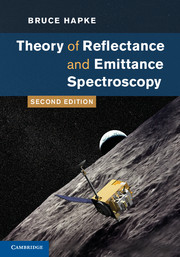Book contents
- Frontmatter
- Contents
- Acknowledgments
- 1 Introduction
- 2 Electromagnetic wave propagation
- 3 The absorption of light
- 4 Specular reflection
- 5 Single-particle scattering: perfect spheres
- 6 Single-particle scattering: irregular particles
- 7 Propagation in a nonuniform medium: the equation of radiative transfer
- 8 The bidirectional reflectance of a semi-infinite medium
- 9 The opposition effect
- 10 A miscellany of bidirectional reflectances and related quantities
- 11 Integrated reflectances and planetary photometry
- 12 Photometric effects of large-scale roughness
- 13 Polarization of light scattered by a particulate medium
- 14 Reflectance spectroscopy
- 15 Thermal emission and emittance spectroscopy
- 16 Simultaneous transport of energy by radiation and thermal conduction
- Appendix A A brief review of vector calculus
- Appendix B Functions of a complex variable
- Appendix C The wave equation in spherical coordinates
- Appendix D Fraunhofer diffraction by a circular hole
- Appendix E Table of symbols
- Bibliography
- Index
12 - Photometric effects of large-scale roughness
Published online by Cambridge University Press: 05 January 2012
- Frontmatter
- Contents
- Acknowledgments
- 1 Introduction
- 2 Electromagnetic wave propagation
- 3 The absorption of light
- 4 Specular reflection
- 5 Single-particle scattering: perfect spheres
- 6 Single-particle scattering: irregular particles
- 7 Propagation in a nonuniform medium: the equation of radiative transfer
- 8 The bidirectional reflectance of a semi-infinite medium
- 9 The opposition effect
- 10 A miscellany of bidirectional reflectances and related quantities
- 11 Integrated reflectances and planetary photometry
- 12 Photometric effects of large-scale roughness
- 13 Polarization of light scattered by a particulate medium
- 14 Reflectance spectroscopy
- 15 Thermal emission and emittance spectroscopy
- 16 Simultaneous transport of energy by radiation and thermal conduction
- Appendix A A brief review of vector calculus
- Appendix B Functions of a complex variable
- Appendix C The wave equation in spherical coordinates
- Appendix D Fraunhofer diffraction by a circular hole
- Appendix E Table of symbols
- Bibliography
- Index
Summary
Introduction
The expressions for reflectance developed in previous chapters of this book implicitly assume that the apparent surface of the particulate medium is smooth on scales large compared with the particle size. Although that assumption may be valid for surfaces in the laboratory, it is certainly not the case for planetary regoliths. In this chapter the expressions that were derived in Chapters 8–10 to describe the light scattered from a planet with a smooth surface will be modified so as to be applicable to surfaces with large-scale roughness. By “large-scale roughness” is meant that areas of the surface larger than the particle size but smaller than the detector footprint are tilted with an irregular distribution of slopes. Persons uninterested in the details of the derivation may wish to jump directly to the Summary Section 12.D, after reading this introductory section.
In calculations of this type we are immediately faced with the problem of choosing an appropriate geometric model to describe roughness. Some authors have chosen specific shapes, such as hemispherical cups (Van Diggelen, 1959; Hameen-Anttila, 1967), that approximate impact craters on the surface of a planet. However, such models may not be applicable to other geometries such as hills or dunes. To make the expressions to be derived as general as possible, it will be assumed that the surfaces are randomly rough.
- Type
- Chapter
- Information
- Theory of Reflectance and Emittance Spectroscopy , pp. 303 - 338Publisher: Cambridge University PressPrint publication year: 2012
- 2
- Cited by



